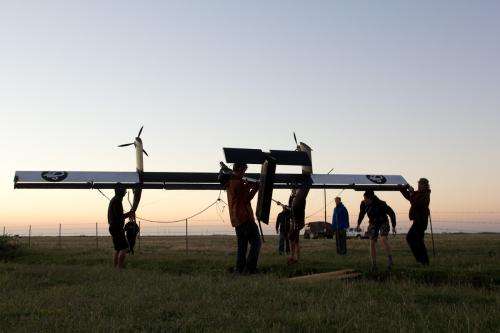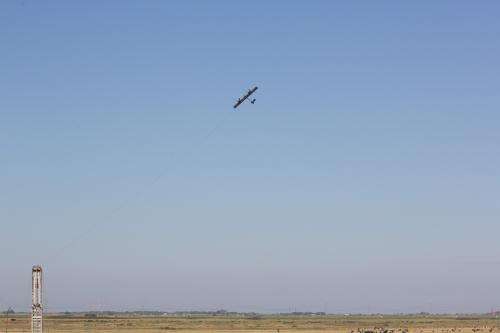October 8, 2011 report
Makani's flying windmills win Breakthrough award

(PhysOrg.com) -- Makani Power, of Alameda, California, creators of the high-altitude wind turbine, is one of this year’s winners of the Popular Mechanics seventh annual Breakthrough Awards. Naming Makani team members Corwin Hardham, Kenny Jensen, and Damon Vander Lind, the award honors these creators of a “sleek, 20-kilowatt Wing 7 prototype” that is “equal parts airplane, helicopter and robot.”
The device elsewhere is being referred to as the “power station in the sky” and described as a “cross breeding between a windmill and a model plane.”
The airborne turbine takes off and moves like a plane, designed to reach winds that blow stronger and more consistently. This ability to reach the stronger winds is no small feat. The system bears an advantage over traditional wind turbines, unable to reach stronger winds that are over one thousand feet above ground. Wing 7 can reach heights of 1,500 feet. The device is said to be able to generate nearly double the energy of conventional turbines. The Wing 7 has a wing span of 8 meters, weighs 56 kg and has a rated power of 20 kW.
Once it reaches a height of about 1,500 feet, the device is flying in swooping circles and is generating electricity. It is called a "20kW power plant" because it can generate 20 kW of energy off of 22 mph winds.
According to a description on the company’s site, the turbines on the leading edge of the wing face into the wind as it flies and generate energy, which is then transmitted to the ground along the tether. Makani’s technology is designed to operate most efficiently at middle altitudes between 1000 and 2000 feet. This flying turbine would carry an unsubsidized real cost that Makani says is “competitive with coal-fired power plants,” the current benchmark of the lowest-cost source of power.

Responding to questions about the device’s possible threat to birds, the company’s FAQ page says that the wind turbines share the airspace with avian life, as the system flies at an altitude well above that of most birds. Also, the absence of a tower makes the system less prone to nesting or perching, according to the company.
Plans are to have these systems to market by 2015. Makani has been on a multi-year development roadmap bolstered by funding from the Department of Energy’s Advanced Research Projects Agency-Energy (ARPA-E) and from Google.
© 2011 PhysOrg.com




















